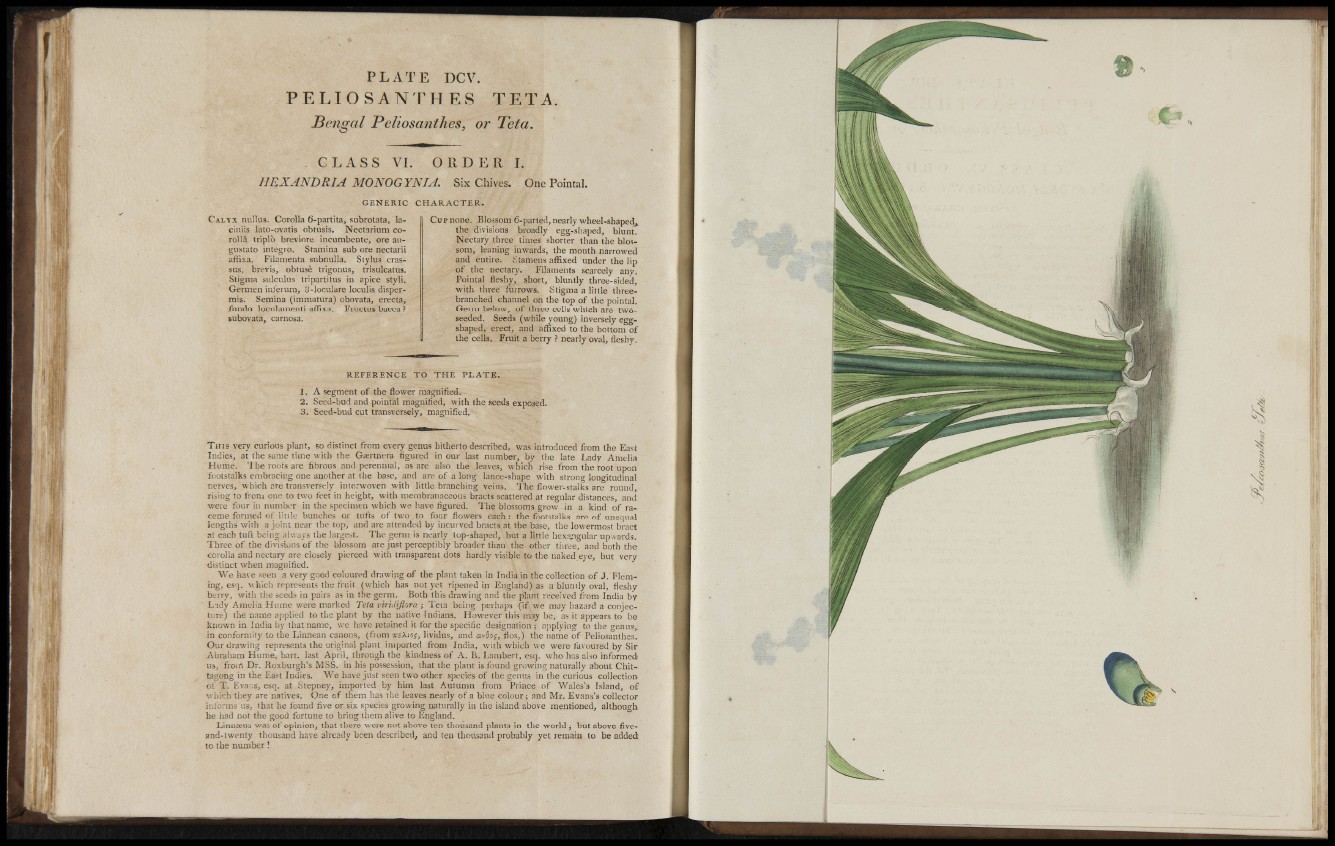
f
!> .,'f *
MI
P L A T E DCV.
P E L I 0 S A N r H E S TETA.
Bengal Peliosanthes, or Teta.
C L A S S VL O R D E R I.
imXJNDRIA MONOGYNLl Six Chives. One Pointal.
GENERIC CHARACTER.
CALYX nullus. Corolla 6-partita, subrotata, laciniis
lato-ovntis obtusis. Nectariuni corolla
triplo breviore incumbente, ore aiigustato
integro. Stamina sub ore nectarii
afiixa. Filaiiienta subnulJa. Stylus crassus,
brevis, obtusè trigonus, trisulcatus.
Stigma sulcukis tripartitus in apice styli.
Germen iníeiura, 3-loculare loculis dispermis.
Semina (immatura) obovata, erecta,
fundo loculamenti afiixa. Fructus bacca ?
subovata, carnosa.
CUP none. Blossom 6-parted, nearly wheel-shaped,
the divisions broadly egg-shaped, blunt.
Nectary three times shorter than the blossom,
leaning inwards, the mouth narrowed
and entire, iitamens affixed under the lip
o f the nectary. Filaments scarcely any.
Pointal fleshy, short, bluntly three-sided,
with three furrows. Stigma a little threebranched
channel on the top of tiie pointal.
Germ below, of three cells which are twoseeded.
Seeds (while young) inversely eggshaped,
erect, and aflixed to the bottom of
the cells. Fruit a berry ? nearly oval, fleshy.
REFERENCE TO THE PLATE.
1. A segment of the flower magnified.
2. Seed-bud and pointal magnified, with the seeds exposed.
3. Seed-bud cut transversely, magnified.
T i t i s very curious plant, so distinct from every genus hitherto described, was introduced from the East
Indies, at the same time with the Gaertnera figured in our last number, by the late Lady Amelia
Hume. The roots are fibrous and perennial, as are also the leaves, which rise from the root upon
footstalks embracing one another at the base, and are of a long lance-shape w'ith strong longitudinal
nerves, w hich are transversely interwoven with little branching veins. 'I'he fiower-stalks are round,
rising to fioni one to two feet in height, with membranaceous bracts scattered at regular distances, and
were four in number in the specimen which we have figured. Ihe blossoms grow in a kind of raceme
formed of iitile bunches or tufts of two to four flowers each: the footstalks are of unequal
lengths with a joint near the top, and are attended by incurved bracts at the base, the low ermost bract
.It each tuft being always the largest. The germ is nearly top-shaped, but a little hexa,igular upwards.
Three of the divisions of the blossom are just perceptibly broader than the other tiiree, and both the
corolla and nectary are closely pierced with transparent dots hardly visible to the naked eye, but verydistinct
when magnified.
W e have seen a very good coloured drawing of the plant taken in India in the collection of J, Fleming,
esq. Mhicb represents the fruit (which has not yet ripened in England) as a blunlly oval, fleshy
berry, with the seeds in pairs as in the germ. Both this drawing and the plant received from India by
L i d y Amelia H ume were marked Tela viriJiJlora ; Teta being ])erhaps (if we may haz.ird a conjecture)
the name applied to the plant by the uafive indians. However this may be, as it appears to be
known in india by that name, we have retained it for the specific designation ; applying to the genus,
in conformity to the Linnean canons, (from •ssXto;, lividus, and avSo;, flos,) the name of Peliosanthes.
Our drawing represents the original plant imported from India, with which we were fa\ oured by Sir
Abraiiam Hume, bart. last April, through the kindness of A. B. Lambert, esq. who has also informed
us, from Dr. Roxburgh's MSS. in his possession, ¡hat the plant is found growing naturally about Chittagong
in the East Indies. We have just seen two other species of the genus in the curious collection
of T. Eva:.s, esq. at Stepney, imported by him last Autumn from Prince of Wales's Island, of
which they are natives. One of them has the leaves nearly of a blue colour; and Mr. Evans' s collector
informs us, that he found five or six species growing naturally in the island above mentioned, although
h e had not the good fortune to bring them alive to England.
Linnaeus was of opinion, that there were not above ten thousand plants in the world ; but above fiveand
twenty thousand have already been described^ and ten thousand probably yet remain to be added
to the number!
i i
a
! 1
¡; ;
• J